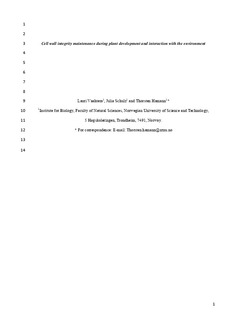| dc.contributor.author | Vaahtera, Lauri | |
| dc.contributor.author | Schulz, Julia | |
| dc.contributor.author | Hamann, Thorsten | |
| dc.date.accessioned | 2020-02-28T11:34:27Z | |
| dc.date.available | 2020-02-28T11:34:27Z | |
| dc.date.created | 2019-10-01T18:50:35Z | |
| dc.date.issued | 2019 | |
| dc.identifier.citation | Nature Plants. 2019, 5 (9), 924-932. | nb_NO |
| dc.identifier.issn | 2055-026X | |
| dc.identifier.uri | http://hdl.handle.net/11250/2644346 | |
| dc.description.abstract | Cell walls are highly dynamic structures that provide mechanical support for plant cells during growth, development and adaptation to a changing environment. Thus, it is important for plants to monitor the state of their cell walls and ensure their functional integrity at all times. This monitoring involves perception of physical forces at the cell wall–plasma membrane interphase. These forces are altered during cell division and morphogenesis, as well as in response to various abiotic and biotic stresses. Mechanisms responsible for the perception of physical stimuli involved in these processes have been difficult to separate from other regulatory mechanisms perceiving chemical signals such as hormones, peptides or cell wall fragments. However, recently developed technologies in combination with more established genetic and biochemical approaches are beginning to open up this exciting field of study. Here, we will review our current knowledge of plant cell wall integrity signalling using selected recent findings and highlight how the cell wall–plasma membrane interphase can act as a venue for sensing changes in the physical forces affecting plant development and stress responses. More importantly, we discuss how these signals may be integrated with chemical signals derived from established signalling cascades to control specific adaptive responses during exposure to biotic and abiotic stresses. | nb_NO |
| dc.language.iso | eng | nb_NO |
| dc.publisher | Nature Research | nb_NO |
| dc.title | Cell wall integrity maintenance during plant development and interaction with the environment | nb_NO |
| dc.type | Journal article | nb_NO |
| dc.type | Peer reviewed | nb_NO |
| dc.description.version | acceptedVersion | nb_NO |
| dc.source.pagenumber | 924-932 | nb_NO |
| dc.source.volume | 5 | nb_NO |
| dc.source.journal | Nature Plants | nb_NO |
| dc.source.issue | 9 | nb_NO |
| dc.identifier.doi | 10.1038/s41477-019-0502-0 | |
| dc.identifier.cristin | 1732718 | |
| dc.description.localcode | This is a post-peer-review, pre-copyedit version of an article. Locked until 9.3.2020 due to copyright restrictions. The final authenticated version is available online at: http://dx.doi.org/10.1038/s41477-019-0502-0 | nb_NO |
| cristin.unitcode | 194,66,10,0 | |
| cristin.unitname | Institutt for biologi | |
| cristin.ispublished | true | |
| cristin.fulltext | original | |
| cristin.fulltext | preprint | |
| cristin.qualitycode | 1 | |
